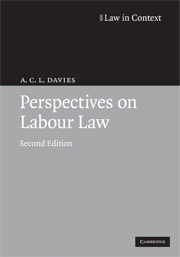Book contents
- Frontmatter
- Contents
- Preface
- Acknowledgements
- Table of statutes
- Table of statutory instruments
- Table of EU legislation
- Table of international instruments
- Table of cases
- Abbreviations
- PART I
- PART II
- 5 Who is protected by employment law?
- 6 Working time
- 7 Discrimination
- 8 Wages
- 9 Dismissal
- 10 Collective representation
- 11 Trade union membership
- 12 Industrial action
- What next?
- Index
10 - Collective representation
Published online by Cambridge University Press: 28 January 2010
- Frontmatter
- Contents
- Preface
- Acknowledgements
- Table of statutes
- Table of statutory instruments
- Table of EU legislation
- Table of international instruments
- Table of cases
- Abbreviations
- PART I
- PART II
- 5 Who is protected by employment law?
- 6 Working time
- 7 Discrimination
- 8 Wages
- 9 Dismissal
- 10 Collective representation
- 11 Trade union membership
- 12 Industrial action
- What next?
- Index
Summary
This chapter is the first of three chapters dealing with the collective dimension of labour law: in other words, its approach to groups of workers. Trade unions are, of course, the classic example of workers grouping together in order to bargain with the employer about terms and conditions of employment. As we saw in Chapter 1, the labour law of the 1950s was designed to support collective bargaining. Today, the law continues to play this role to some extent. However, collective bargaining is no longer the sole mechanism through which workers may present their views to the employer. Duties derived from EC law to consult with employees also form an important part of labour law. Consultation may involve trade unions, but it need not do so. This chapter will address the two main controversies that arise in this area: whether workers should have a say in the running of the workplace at all and, if so, what form their participation should take.
Human rights instruments generally support some form of worker participation. Civil and political rights instruments usually contain a right to form and join trade unions ‘for the protection of [the individual's] interests’. Commentators have argued that this phrase could be used to support a right to engage in collective bargaining, but interpretations (for example, by the ECtHR) have not always confirmed this view. Economic and social rights instruments usually contain an express right to collective bargaining. Consultation is a recent innovation and makes an appearance only in the most modern economic and social rights instruments, such as the EU Charter and the revised ESC 1996.
- Type
- Chapter
- Information
- Perspectives on Labour Law , pp. 176 - 196Publisher: Cambridge University PressPrint publication year: 2009



